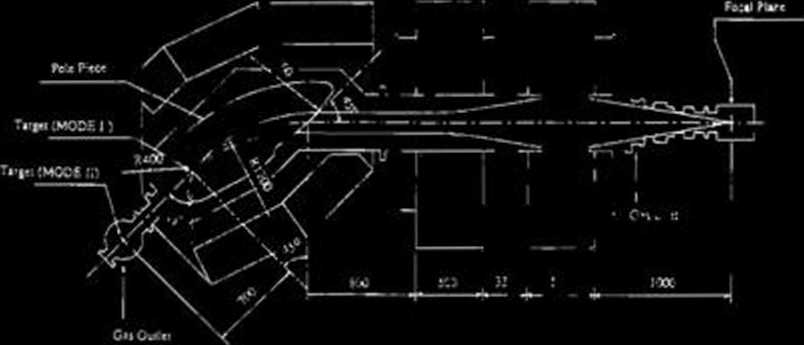372596141
103
RIKEN Accel. Próg. Rep. 24 (1990)
111-5-9. Test Experiment of the GARIS/IGISOL
K. Morita, T. Nomura, A. Yoshida, T. Inamura, M. Koizumi, M. Fujioka, T. Shinozuka, H. Miyatake, K. Sueki, H. Kudo, Y. Nagai, K. Yoshimura, and T. Toriyama
We constructed an isotope separator on-line (ISOL) at the El experimental hall of the RIKEN Ring Cyclotron (RRC) facility. Since the ISOL consists of a gas-filled recoil isotope separator (GARIS) and an ion-guide type isotope separator on-line (IGISOL), we cali the system as GARIS/ IGISOL. The GARIS/IGISOL will provide us with short-lived isotopes which will be produced by nuclear reactions with high-energy heavy-ion beams from RRC for the study of spectroscopic features of these isotopes. The construction and the generał specifications of the system were reported in Ref. 1.
The GARIS consists of three magnets of a D-Q-Q configuration. The shape of the pole piece of a D-magnet and the geometrical setup of magnets are shown in Fig. 1 together with a beam trajectory obtained by first order calcula-tion. The characteristics of the system as a
D C Q3

Fig. 1. Geometrical setup of GARIS. A trajectory calcu-lated is shown.
Table 1. Characteristics of GARIS as a spectrograph.
|
Model |
Modę 11 | |
|
Target posidon |
Pole boundary |
Center of the scattcring chamber |
|
Totai length of the trajectory |
4.07 m |
4.77 m |
|
Trajectory length in the magnedc field |
1.94 ni |
1.94 m |
|
Dtspersion |
0.20 cmJ% |
0.78 cm/% |
|
Angular acceptance (horizoltal) |
±87.5 mrad |
±81.3 mrad |
|
Angular acceptance (vertical) |
±78.5 mrad |
±68.5 mrad |
|
Solid angle (design value) |
12 8 msr |
11.2 msr |
|
(measured value) |
16.3 msr |
12.1 msr |
|
Magnificadon (horizonial) |
0.57 |
0.74 |
|
Magnificadon (vcrtical) |
1.47 |
1.51 |
magnetic spectrograph are listed in Table 1. Solid angular acceptances were measured with use of 241 Am a-source, and their values are listed also in Table 1.
The efficiency of GARIS was measured by comparing the activity yields on a catcher detec-tor at the focal piane of the GARIS with those on catcher foils at about 5 cm behind targets. Abso-lute efficiencies (in the entire energy-range of the reaction products) were found to be 15 ±1% for the 169Tm (40Ar, xn) (E(40Ar) = 5 MeV/u) reaction (fusion reaction), 5.3±0.4% for the ,81Ta (40Ar, tfxn) (E(40Ar) = 6 MeV/u) reaction, and 0.5± 0.1% for the natW(14N, X),69Hf(E(l4N) = 35 MeV/ u) reaction (target fragmentation). The efficiencies strongly depend not only on the angular distributions of the reactions but also the energy distributions of the recoiled products. The efficiencies of GARIS for recoiled products of morę than 18 MeV were found to be 30 ±3% for the fusion reaction, and 12±2% for the (HI, ^xn) reaction.
The parameters of the ion optics of IGISOL were tuned with an 40Arl+ ion beam and i28-i36^ei+ jon 5eams produced by discharge
between needles set inside a thermalization chamber which contains helium added with a smali amount of argon or xenon gas. The mass resolving power [A! A A) obtained by these timing were found to be about 120 for Ar-ion and about 250 for Xe-ions when the helium gas pres-sure was 100 mbar.
The efficiency of IGISOL was measured by l41Pr(40Ar, xn)181~xIr reactions under various experimental conditions. Recoiled Ir isotopes were collected with GARIS, then injected into the thermalization chamber of IGISOL, and then stopped there. The isotopes passed through the exit hole of the chamber with a helium gas-flow and were separated from helium atoms with a skimmer, ions were then accelerated to 30 keV with an electrostatic field. The accelerated ions were then collected on the surface of a Silicon surface barrier detector set inside a beam tubę just before an analyzer magnet of IGISOL. (3-Rays and a-particles emitted from the Ir isotopes were detected with the detector, and the effi-
Wyszukiwarka
Podobne podstrony:
92 RIKEN Accel. Próg. Rep. 24 (1990)111-5. Instrumentation1. Design of a Microbeamline for a Compact
116 RIKEN Accel. Próg. Rep. 24 (1990)111-5-19. Responses of Large Position-Sensitive Detectorsto Hea
11 RIKEN Accel. Próg. Rep. 24 (1990)111-1-2. Three a Disintegration of 12C in the Field of208Pb Nucl
63 RIKEN Accel. Próg. Rep. 24 (1990)111-2-28. Development of Nuclear Track Microfilters N. Nakanishi
72 RIKEN Accel. Próg. Rep. 24 (1990)111*3-8. Dry Separation of Radioactive Nuclides from a Gold Targ
80 RIKEN Accel. Próg. Rep. 24 (1990)111-3-16. Development of an lon Beam Sputtering Method toPrepare
63 RIKEN Accel. Próg. Rep. 24 (1990)111-2-28. Development of Nuclear Track Microfilters N. Nakanishi
94 RIKEN Accel. Próg. Rep. 24 (1990)111-5-2. Design of a Decay Muon Channel Using an Axially Symmetr
102 RIKEN Accel Próg. Rep. 24 (1990)111-5-8. Performance of Isotopic Separation in RIPS T.Nakamura,
105 RIKEN Accel. Próg. Rep. 24 (1990)111-5-10. Velocity Distribution of IGISOL lon Beams M. Koizumi,
108 RIKEN Accel. Próg. Rep. 24 (1990)111-5-12. Status Report of the RIKEN Swinger-Magnetic Analyzer
110 RIKEN Accel. Próg. Rep. 24 (1990)111-5-14. Test for Dispersive-Mode Beam Transportto the SMART
RIKEN Accel. Próg. Rep. 24 (1990)111-5-25. High Speed Serial Data Link for PC-9801 J. Fujita > PC
więcej podobnych podstron